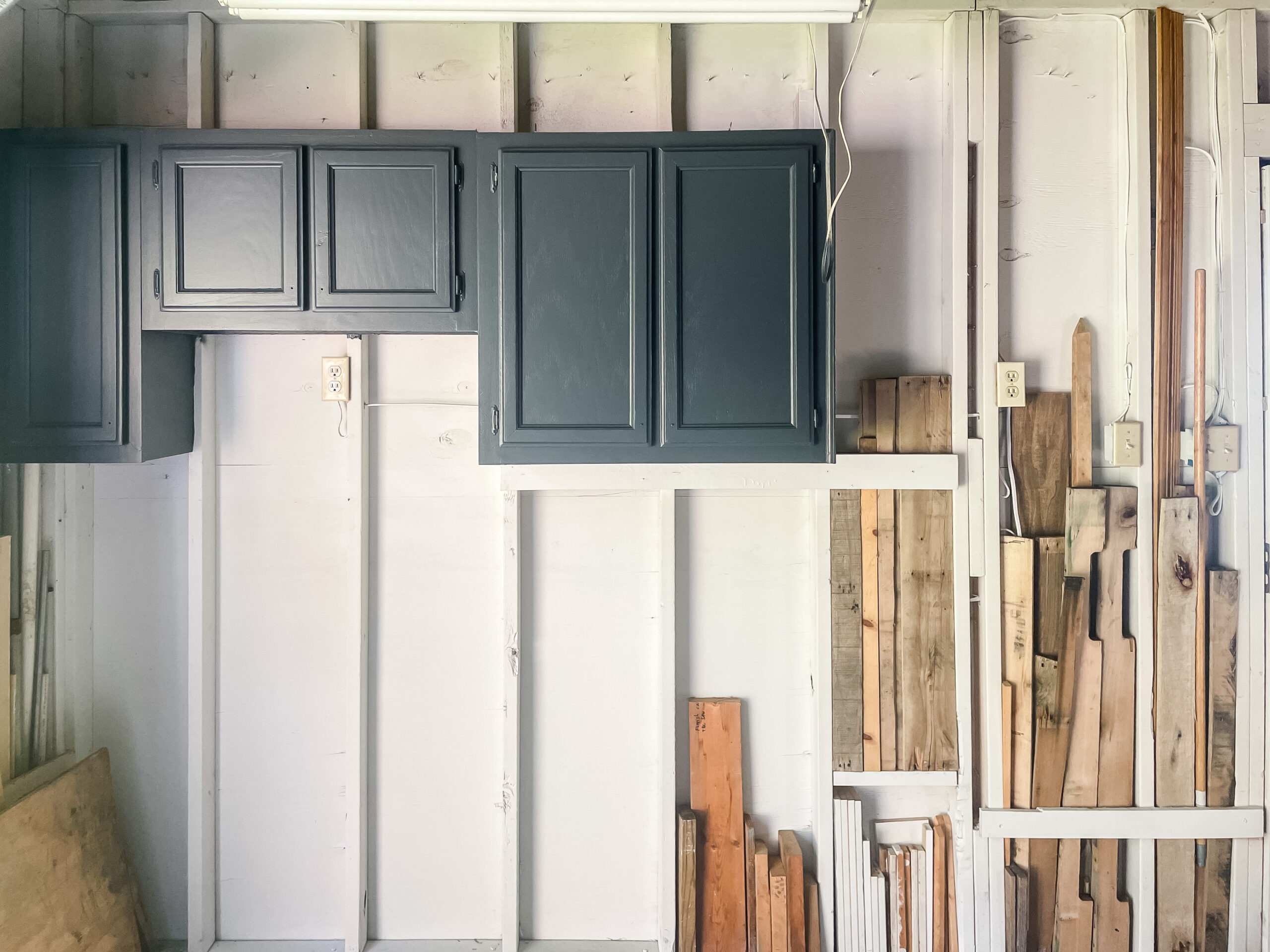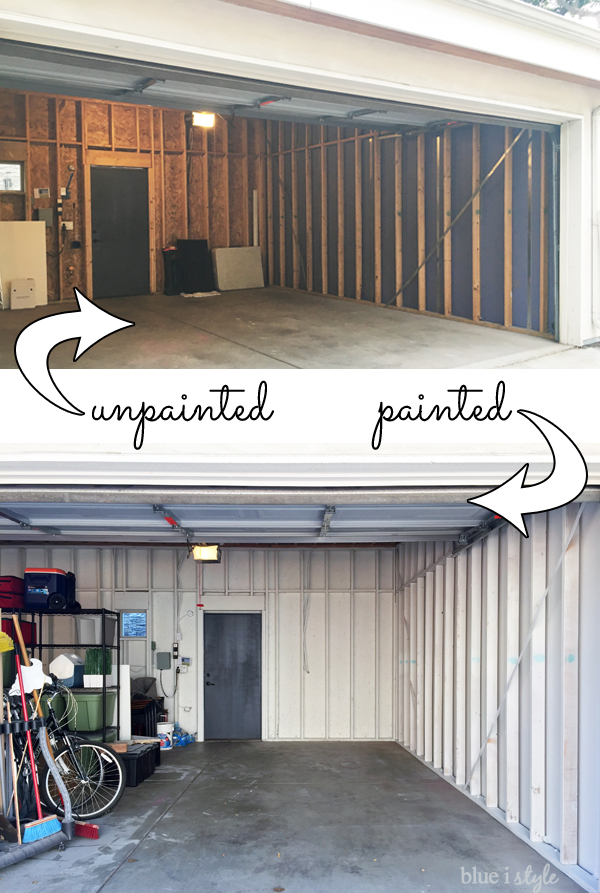To paint unfinished garage walls, start by cleaning and priming the surfaces. Then, apply paint using a roller for an even finish.
Embarking on a project to paint your garage’s unfinished walls can transform a dull, utilitarian space into a bright, inviting area. This simple upgrade not only enhances the aesthetic appeal of your garage but also protects the walls from moisture and wear.
Painting is a cost-effective way to add value to your home and can be a satisfying weekend project. The key to a successful paint job lies in thorough preparation and choosing the right materials for your garage’s specific conditions. With a little effort, you can achieve professional-looking results that make your garage feel like a new part of your home.

Credit: www.sarahhearts.com
Introduction To Garage Wall Painting
Painting unfinished garage walls can transform a dull space into a clean, bright area. It’s not just about looks. A fresh coat of paint protects walls from moisture and mold. It also makes cleaning easier. This guide helps you start your garage makeover.
Benefits Of Painting Unfinished Garage Walls
- Improved appearance: Brightens the space.
- Protection: Shields walls from damage.
- Increased value: Boosts home value.
- Maintenance: Simplifies cleaning.
Materials Needed For The Project
| Material | Use |
|---|---|
| Primer | Prepares the wall surface |
| Paint | Colors and protects walls |
| Brushes and Rollers | Applies primer and paint |
| Painter’s Tape | Protects edges and trim |
| Drop Cloths | Covers floors and items |
| Sandpaper | Smooths wall imperfections |
| Ladder | Reaches high areas |

Credit: emilyronehome.com
Preparation Steps
Before splashing color on your garage walls, preparation is key. It ensures the paint sticks well and lasts long. Here are the initial steps to prepare your unfinished garage walls for a fresh coat of paint.
Cleaning The Walls
Clean walls are vital for the paint to adhere properly. Dust, dirt, and grease can prevent paint from sticking. Follow these steps:
- Remove all items from the wall.
- Dust the walls with a broom.
- Mix warm water and mild detergent.
- Wipe the walls with a sponge or cloth.
- Rinse with clean water.
- Let the walls dry completely.
Repairing Wall Damage
Next, address any damage to ensure a smooth surface. Follow these steps:
- Inspect walls for holes or cracks.
- Use spackle or joint compound to fill them.
- Apply with a putty knife.
- Wait for the filler to dry.
- Sand the area until smooth.
- Wipe away sanding dust.
Choosing The Right Paint
Choosing the Right Paint is crucial for your garage’s durability and style. The right paint withstands daily wear and tear. It transforms a dull space into a vibrant one. Let’s explore the best paint types and colors for your garage walls.
Types Of Paint Suitable For Garages
Garage walls need tough paint. The paint should resist moisture, mold, and stains. Two types stand out:
- Epoxy: This durable paint resists chemicals and abrasions.
- Latex: Latex paint is easy to clean and quick to dry.
Both options come in various finishes. These include matte, semi-gloss, and gloss. Glossy finishes make cleaning easier. They reflect light well, brightening up your garage.
Selecting A Color Scheme
Color impacts mood and perception. Light colors make spaces feel larger. They hide dust and dirt less than dark colors. Consider these points:
| Color | Effect |
|---|---|
| White | Brightens; enlarges space. |
| Gray | Neutral; hides smudges. |
| Blue | Calm; focuses mind. |
Consider your garage’s lighting and function. Pick colors that match your home’s style. Test paint samples before deciding. This ensures satisfaction with the final look.

Credit: www.blueistyleblog.com
Applying Primer
Before painting your garage walls, applying primer is key. This step ensures your paint adheres well and lasts longer. Let’s dive into why primer is beneficial and how to apply it properly.
Benefits Of Using A Primer
- Improves Paint Adhesion: Primer makes paint stick better.
- Seals Porosity: It fills tiny holes for a smooth finish.
- Blocks Stains: Prevents old stains from showing through.
- Enhances Durability: Helps paint withstand wear and tear.
Step-by-step Primer Application
- Prepare Walls: Clean walls and let them dry.
- Select Primer: Choose a primer suited for your wall type.
- Apply Primer: Use a roller for large areas, brush for edges.
- Let Dry: Wait for the primer to dry completely.
- Inspect: Check for missed spots and apply a second coat if necessary.
Applying primer is simple but crucial for a lasting finish. Clean walls, pick the right primer, roll it on, let it dry, and check your work. These steps lead to a smooth, durable painted garage wall.
Painting Techniques
Let’s dive into the world of painting techniques for your garage. Painting unfinished garage walls can transform the space. It’s not just about picking a color. The tools and methods matter a lot. We will explore brushes, rollers, and sprayers. Plus, how to apply that first coat of paint.
Brush Vs. Roller Vs. Sprayer
Each tool has its pros and cons. Your choice depends on the finish you want.
- Brush: Good for small areas and edges. It gives control but is slow.
- Roller: Perfect for large, flat surfaces. It’s faster than a brush but might miss spots.
- Sprayer: The quickest option. It covers evenly and reaches everywhere. But, it needs more prep to avoid mess.
Applying The First Coat Of Paint
Starting right ensures a smooth finish. Follow these steps for the first coat:
- Prep the walls. Clean and prime them first.
- Choose the right paint. Latex is best for garages.
- Mix the paint well. This ensures an even color.
- Start from the top. Work your way down to avoid drips.
- Let it dry. Check the paint can for drying times.
Remember, patience is key. The first coat might look uneven. That’s okay. A second coat will cover it.
Additional Coats And Finishing Touches
Once the primer sets, the real transformation begins. Painting unfinished garage walls needs attention to detail. Additional coats enhance durability and appearance. The final touches bring life to the space, creating a clean and inviting area.
Determining The Number Of Coats Needed
Wall texture and paint type determine the coat number. Light colors may require more layers over primer to prevent bleed-through. Test a section before full application. This ensures coverage is even and complete.
Achieving A Smooth Finish
For a smooth finish, quality tools are essential. Use high-density foam rollers for a fine texture. Sand lightly between coats with fine-grit sandpaper. Always remove dust before applying the next layer. This process will leave walls looking professionally painted.
- Inspect walls after each coat dries.
- Address any drips or uneven areas.
- Apply additional coats as needed for uniformity.
Maintenance And Upkeep
Maintenance and Upkeep are crucial for a pristine garage space. Freshly painted walls can transform a garage. Yet, walls face dust, spills, and scuffs over time. Proper care extends paint life and keeps walls looking new.
Cleaning Painted Garage Walls
Regular cleaning maintains the paint’s appearance. Follow these simple steps:
- Use a soft cloth or sponge.
- Mix mild detergent with warm water.
- Gently wipe walls to remove dirt.
- Avoid harsh chemicals that can damage paint.
- Rinse with clean water and dry with a towel.
Touch-up Strategies
Over time, walls get scratches and dings. Here’s how to touch-up paint:
- Clean the area to be touched up.
- Sand the spot lightly if needed.
- Apply primer to bare spots.
- Use the original paint for a perfect match.
- Feather the edges for a seamless look.
Keep leftover paint labeled for easy touch-ups. Small efforts maintain a clean and fresh look.
Safety And Ventilation
Before diving into painting your garage walls, consider safety and ventilation. These steps protect your health and ensure a quality finish. Let’s focus on how to set up a safe painting environment.
Ensuring Adequate Ventilation
Proper airflow is crucial when painting indoors. Follow these tips:
- Open all doors and windows to create a cross breeze.
- Use box fans in windows to pull fumes outside.
- Take frequent fresh air breaks to avoid inhaling fumes.
Personal Protective Equipment
Wearing the right gear is important. Here’s what you need:
- Wear a N95 mask to filter out paint particles.
- Protect your eyes with safety goggles.
- Gloves keep your hands clean and safe from chemicals.
- Long sleeves and pants prevent skin exposure to irritants.
Frequently Asked Questions
What Materials Do I Need To Paint Garage Walls?
Before starting your project, gather primer, paint, rollers, brushes, painter’s tape, sandpaper, and drop cloths.
How Do I Prepare Unfinished Garage Walls For Painting?
Clean the walls, fill any holes or cracks with spackle, and sand the surfaces smooth. Apply a quality primer to ensure paint adhesion.
Is Priming Necessary For Unfinished Garage Walls?
Yes, priming is essential as it helps the paint adhere better and provides a uniform base for the topcoat on unfinished surfaces.
What Type Of Paint Is Best For Garage Walls?
Use a latex-based, exterior-grade paint that resists mold and mildew for durability and easy maintenance in garage environments.
How Long Does It Take To Paint A Garage?
The painting process can take a few hours to a full day, depending on the garage size and the paint’s drying time between coats.
Conclusion
Wrapping up, tackling unfinished garage walls doesn’t have to be daunting. With the right tools and techniques, you can easily transform this space. Remember, proper preparation and choosing the right paint are key. Now, it’s time to grab those brushes and give your garage a fresh, new look.
Happy painting!




